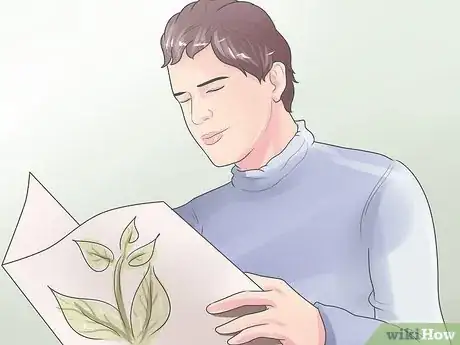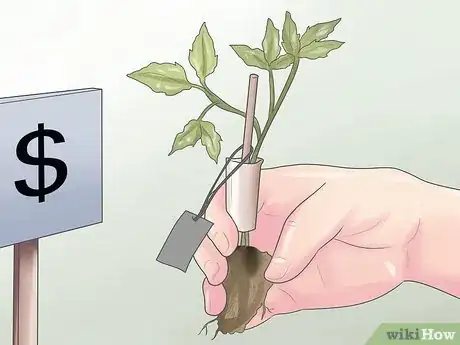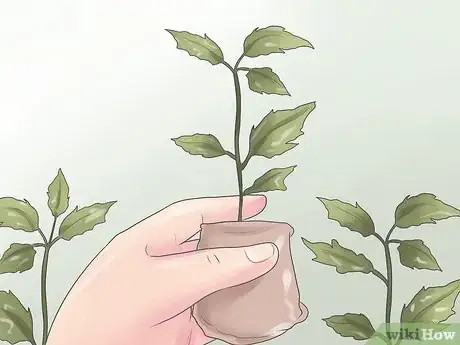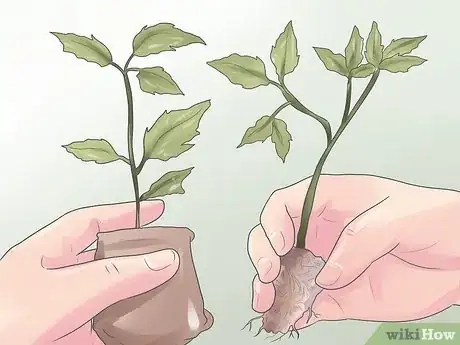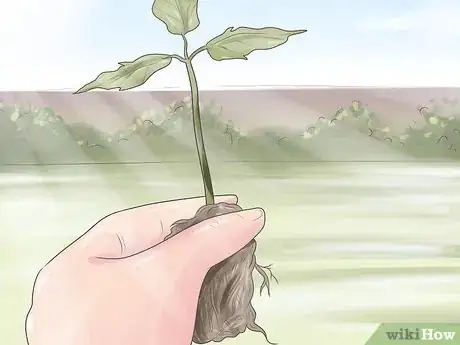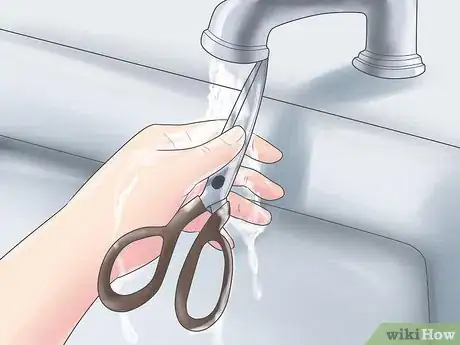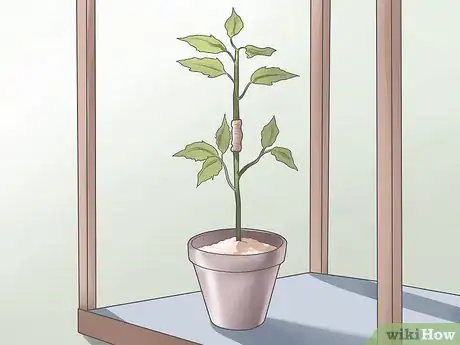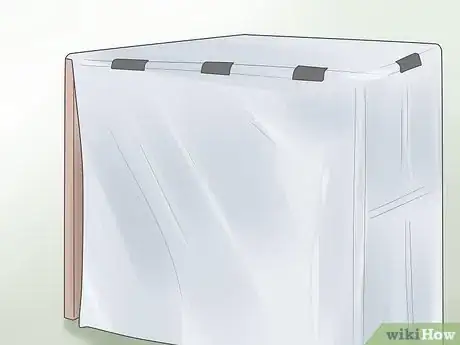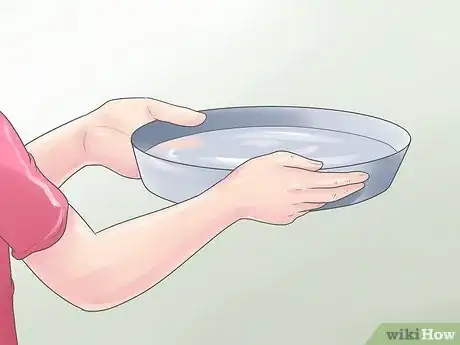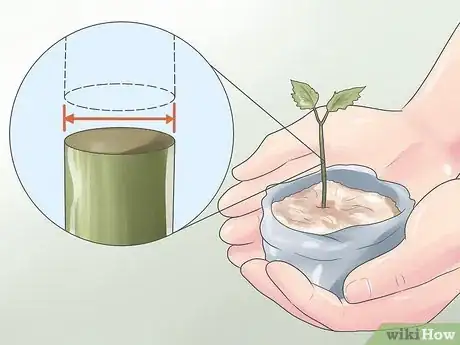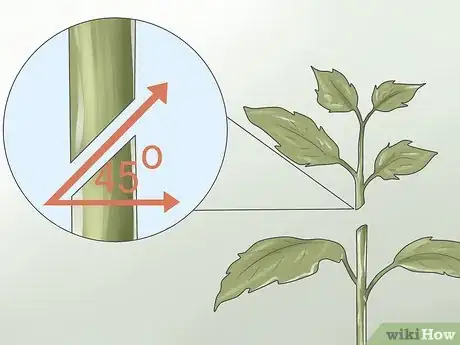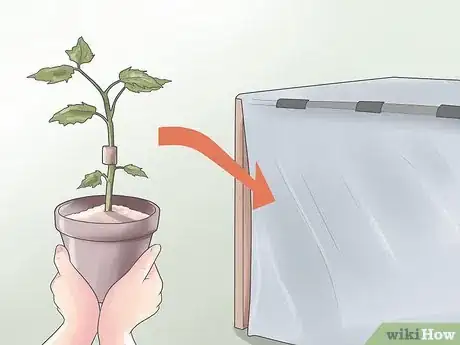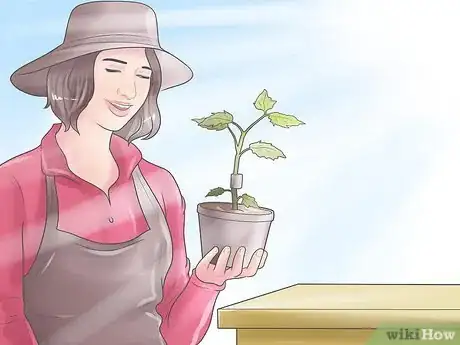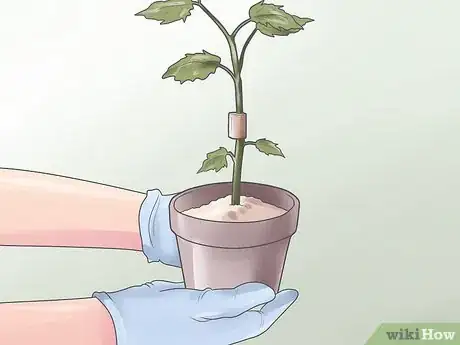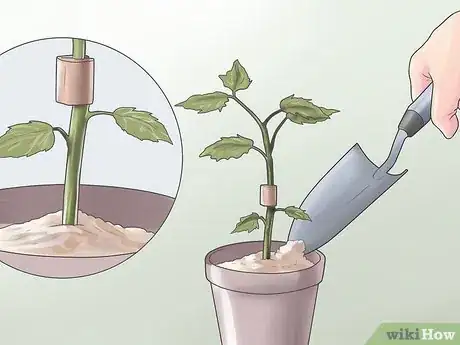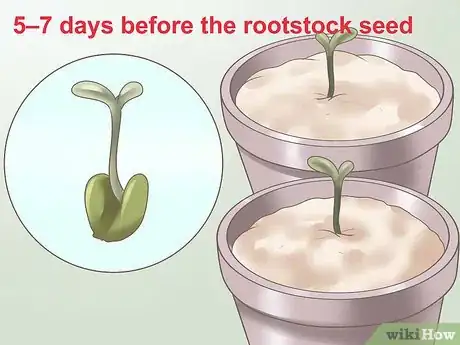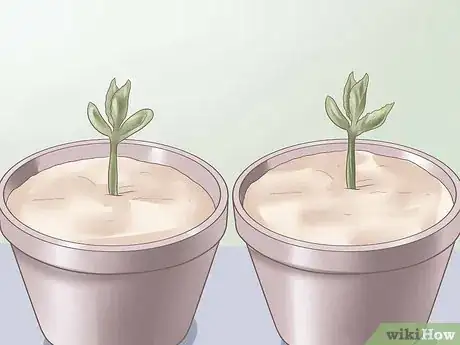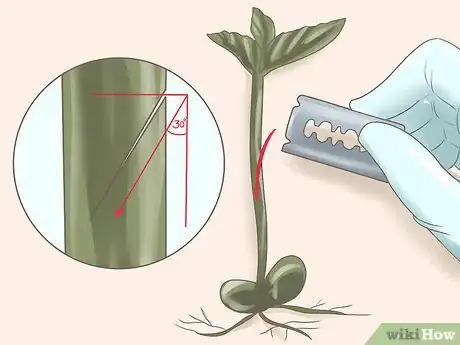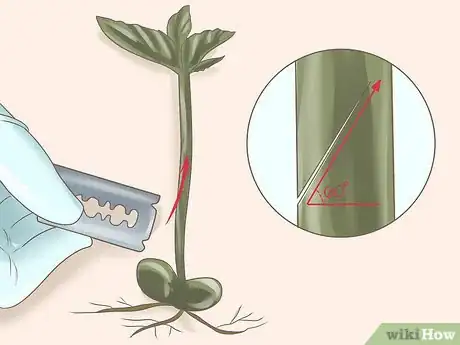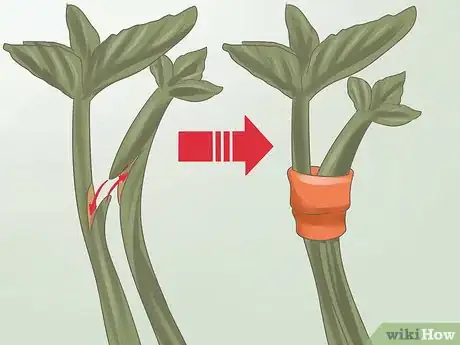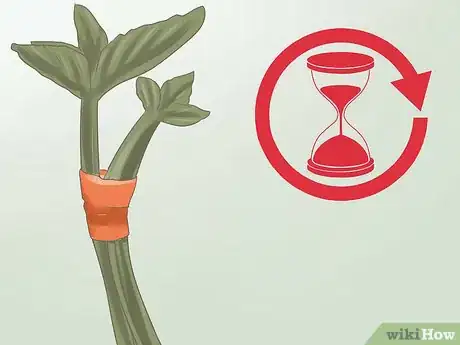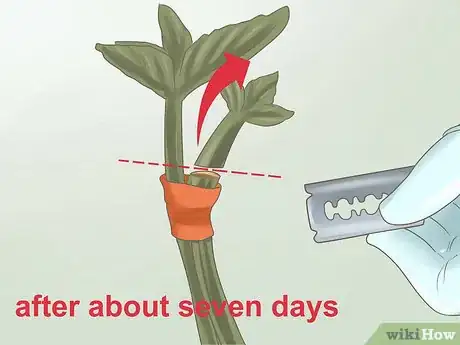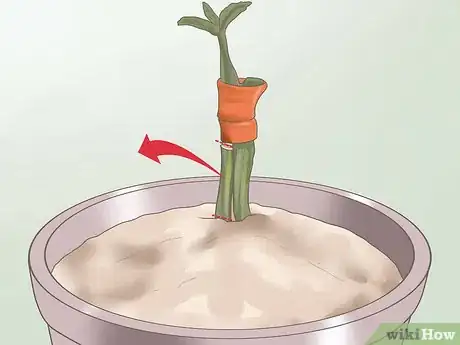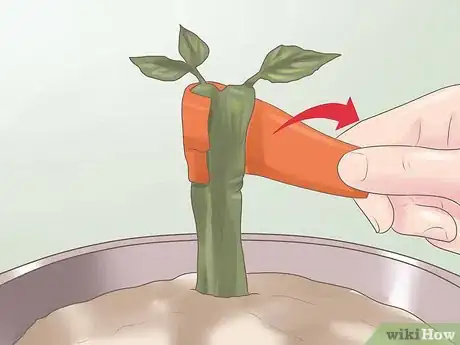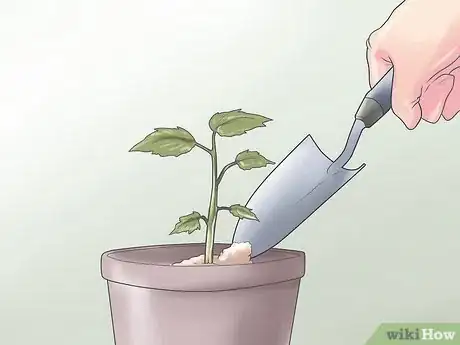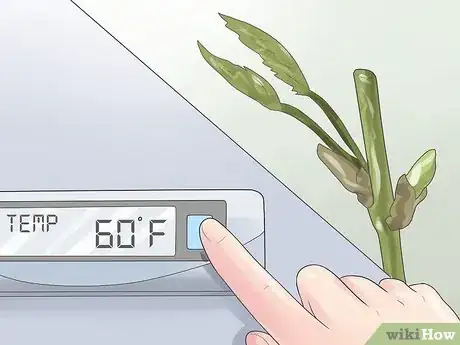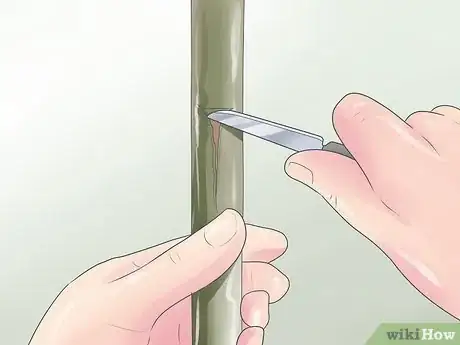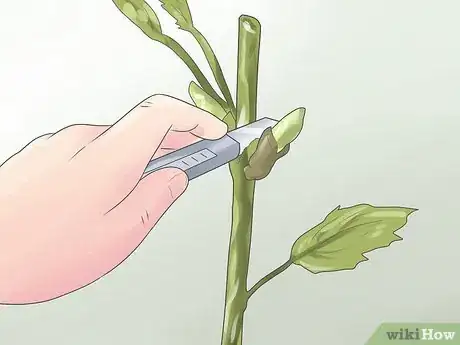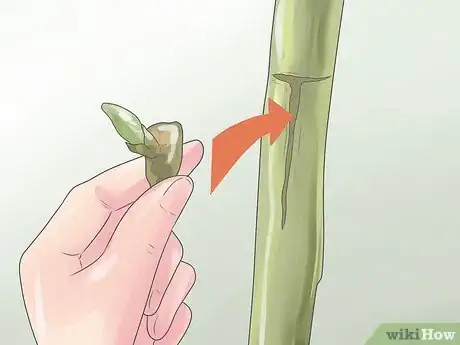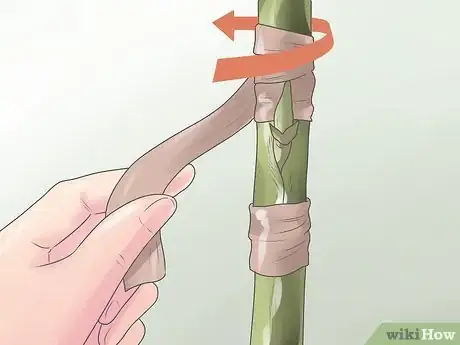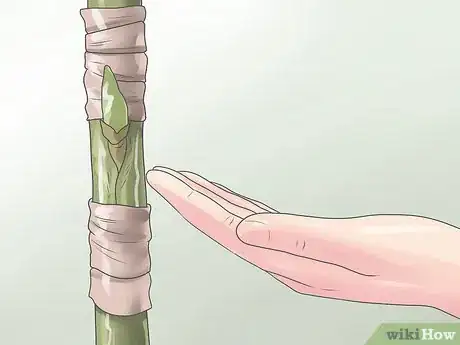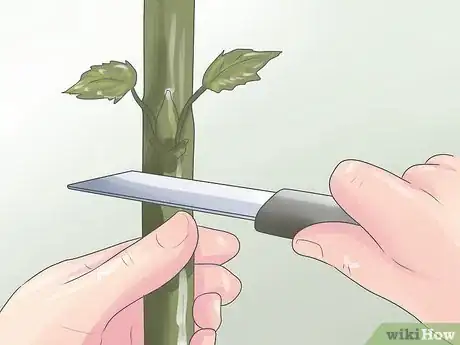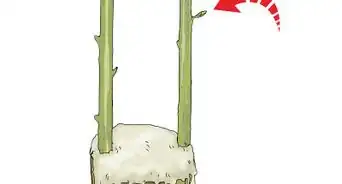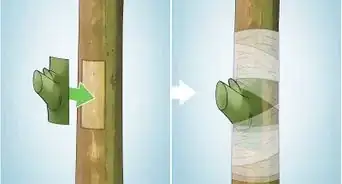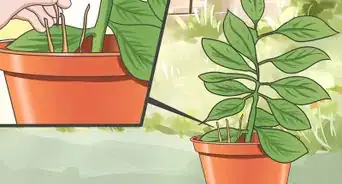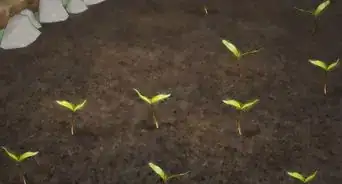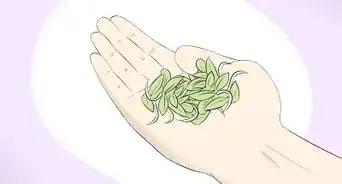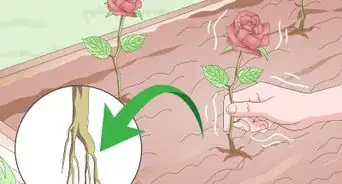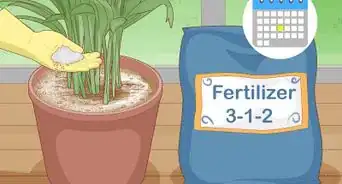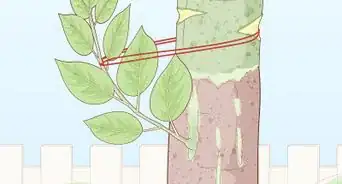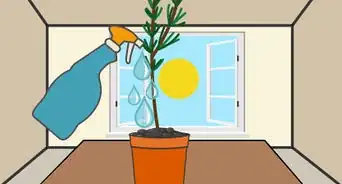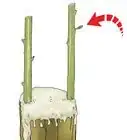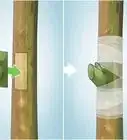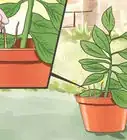This article was co-authored by Andrew Carberry, MPH. Andrew Carberry is a Food Systems Expert and the Senior Program Associate at the Wallace Centere at Winrock International in Little Rock, Arkansas. He has worked in food systems since 2008 and has experience working on farm-to-school projects, food safety programs, and working with local and state coalitions in Arkansas. He is a graduate of the College of William and Mary and holds a Masters degree in public health and nutrition from the University of Tennessee.
There are 10 references cited in this article, which can be found at the bottom of the page.
wikiHow marks an article as reader-approved once it receives enough positive feedback. In this case, 93% of readers who voted found the article helpful, earning it our reader-approved status.
This article has been viewed 327,883 times.
Grafting is a technique of combining two plants or pieces of plants so they grow together. This allows you to combine the qualities of a strong, disease-resistant plant with the qualities of another plant, usually one that produces good fruit or attractive flowers. While there are many methods of grafting, the methods described here should allow you to graft almost any vegetable or fruit seedling, flowering bush, and even certain trees such as citrus trees. For information on grafting larger branches or different types of trees, see the article Graft a Tree.
Steps
Understanding Grafting Basics
-
1Understand the purpose of grafting. Fruit plants, including tomatoes and others sometimes thought of as vegetables, are bred and cross-bred over many generations to improve their attributes. However, no one variety is perfect. By removing a section of a plant that produces great fruit and grafting it onto a variety that absorbs nutrients well and resists disease, you can create a plant with the benefits of each.
- Because you're trying to combine specific attributes, there's no advantage to grafting two plants of the same variety together.[1]
- The resulting plant will not produce offspring with the same mix of qualities. The seeds are produced by the top, grafted portion only.
-
2Purchase high-quality rootstock seeds or plants. The rootstock plant is the plant that provides a root system and base. Because these are carefully bred for certain qualities, they are typically more expensive than standard seeds, sometimes around 50¢ for a single seed. Pick a rootstock that has the qualities you're looking for.
- Generative rootstock puts more energy into producing fruit, but is more vulnerable to disease, cold, and heat. Consider using these in mild climates such as the Pacific Northwest, and harvest small fruit as soon as it ripens.
- Vegetative rootstock tends to be less fragile and handles heat better, but won't produce fruit quickly. It is ideal for long, hot growing seasons.
- Pick a rootstock specifically resistant to diseases in your area if you have problems with disease-ridden plants.
Advertisement -
3Select a compatible variety of the same species for the fruit-producing plant. The fruit-producing, or scion, plant produces the better fruit, and its top will be grafted onto the rootstock. Research your rootstock to find out which varieties will thrive when grafted onto it.[2] If you are running a farm or commercial operation, you should research which scion plant will produce the type of fruit you're looking for.
- Note: most plants cannot be grafted onto a plant of a different species (for instance, a cucumber cannot grow on a tomato plant). Some plants can be grafted onto related species in the same genus or family, but you should ask an expert or search online to determine whether that applies to your plants before attempting.[3]
-
4Use two plants of the same size. Grafting is most successful when the rootstock (base) variety and the scion (top) variety have the same size stem. Plant your rootstock seeds and scion seeds in separate, labeled containers. If you know that one variety grows faster than the other, plant at different times so they'll reach the best grafting stage at the same time. The grafting stage for each type of graft is described in the methods below.
- Plant several seeds at least of each variety, since there's always a chance some won't grow or survive the grafting process. If you're growing large numbers of plants, you can use an online "seed calculator" to determine how many you'll need to plant.
-
5Graft during early morning or just after sunset. At these times, the plant will be moving water from its roots to its leaves (transpiring) at a slower rate, which makes it less vulnerable to stress from grafting and the accompanying water loss. Ideally, you should carry out the grafting indoors and in a shaded location.[4]
- If you can only graft the plants at another time, move them to a shady spot in the early morning of the day you plan to graft.
-
6Sanitize your tools to reduce the risk of infection. Since you'll be making an open cut into the plant, you should keep your hands and tools as clean as possible to reduce the chance of an infection entering the plant. Sanitize your cutting tool before you begin. Scrub your hands with anti-microbial soap and put on latex gloves.[5]
-
7Treat newly grafted plants with special care. Plants that have just been grafted are more vulnerable to temperature changes and infection until the two plants have sealed together. For some types of grafting, you'll need to have a "healing chamber" ready where you can control the environment carefully. Chamber construction is described in more detail in the top graft section. The other methods listed here do not require one.
Grafting with Top Grafts (Tomato and Eggplant Plants)
-
1Construct a healing chamber in advance. A healing chamber is necessary to protect the newly grafted plants while they are healing. For one or two plants, simply have a large plastic bag handy to place over each plant after the grafting occurs. For a larger number of plants, and a better chance of survival, build or purchase a large wooden or PVC frame, then draping it fully with polyethylene sheeting. Have a tarp or opaque shade cloth ready to block most sunlight from entering the chamber during the first stage of healing.[6] Place a bench in the chamber to hold your plants.
- Use a frame with a peaked roof so condensation runs down the sides and doesn't drip onto the plants.
-
2Add pans of water to the chamber and monitor the environment. Place shallow pans of water around the floor of the chamber to increase the humidity. Before you graft any plants, you should monitor the environment in the healing chamber for at least several days to make sure it is stable. The temperature levels should be constant between 70 and 80ºF (21–27ºC) and the humidity should be 80–95%.[7]
- Note that you should not store any plants in this chamber until they are grafted.
-
3Choose plants that are 2–5 inches (5–13cm) tall and have equal diameters. Grafting is most successful on young tomato and eggplant plants, whose stems are still green (herbaceous) instead of woody. The stems should not have grown noticeably thicker, and each plant is usually ready when it has 2–4 true leaves. The most important note to remember is that the two plants should have stems with exactly the same size, so they can grow together without difficulty.
- Note that the first one or two leaves the plant grows will be "seed leaves", not true leaves. These should be easily identified as they will be a different shape or size than the true leaves, but the exact appearance depends on species.
- If it's not possible to find stems of exactly the same size, you must use a rootstock (base) stem larger than the scion (top) stem. The other way around will not work.
-
4Cut each plant in half at a 45º angle. Use a sterilized razor blade or sharp knife to cut through the rootstock (base plant) and scion (top plant) stems. While the exact angle is not important, you should use the same angle for each so they fit together as closely as possible. Make the cut in one motion to keep the surface as flat as possible. Discard the top half of the rootstock and the bottom half of the scion plant.
- Cut each plant above the smaller lower "seed leaf" but below the higher, full size leaves to prevent the scion plant from attempting to grow roots, which can lead to infection.[8]
- See Understanding Grafting Basics for more information on rootstock and scion plants.
-
5Join the two plants together with a grafting clip. These clips may be made from silicone or rubber and should be available at gardening stores or online. Try to match the angles of the cut surfaces as precisely as possible, then hold the plants in place by closing the grafting clip around them.
-
6Move the new hybrid plant to a humid, dark environment immediately. The plant must have time to grow the two vascular systems together, which allows sap to flow through the plant. During this time, keep the plant in a humid, dark environment to minimize the amount of water loss from the scion plant until this happens.
- The healing chamber described earlier is perfect for this, with an opaque shade protecting it from the sun. For a smaller operation, put a plastic bag over the plant and keep out of direct sunlight. Water the base of the plant or mist its leaves if the environment is below 85% humidity.[9]
-
7Gradually return the plant to more sunlight. You should keep the plant in the special environment for at least 4 days, and it will often take a week before the leaves return to a full, healthy state. Even then, you should gradually alter the environment for another few days, or up to a week.[10] Increase the amount of sunlight it receives gradually and reduce the humidity by occasionally removing a pan of water or lifting up the plastic a little higher.
- Wilting is normal for the first day, but mist the plant's leaves if it occurs. If the plant continues to wilt for three or four days, the graft was unsuccessful. Although this method is quite reliable, this still happens about 5% of the time even in the best of circumstances.[11]
-
8After two weeks, return surviving plants to normal growing conditions. If the plant's leaves are still wilted, they are not likely to survive, or at least not likely to do well this growing season. The healthy plants can now be returned to normal growing conditions for a seedling about to be planted. The exact conditions will vary according to species.
-
9Plant the hybrid with the graft clip well above the soil. The point where the two plants are joined should be at least 1 inch (2.5cm) above the soil, to reduce the chance of the upper scion plant trying to grow roots. There is no need to remove the grafting clip, which should fall off on its own as the plant grows.[12]
- Do not hesitate to prune away roots growing from the scion or shoots growing from the rootstock. You may also wish to prune away smaller branches so more energy goes into fruit production.
Grafting with the Tongue Approach Method (Melon and Cucumber Plants)
-
1Plant the scion seed 5–7 days before the rootstock seed. As a general rule, the scion seed, which is selected for its fruit, should be planted earlier than the rootstock seed, selected for other qualities such as disease resistance.[13] You can plant at more precise times if you know the growing rate of each variety.
- Plant in small containers. For this method, you will need to attach the two plants while each is still attached to its own roots, so they need to be able to reach each other without being transplanted.
-
2Prepare to graft when both plants have their first true leaf. The first leaves to emerge from a seedling are small seed leaves that do not look like the leaves of an adult plant. After one or two of these have grown, a true leaf with a noticeably different shape will grow. When both plants are at this stage, they are ready to be grafted together.[14]
- You'll have the highest chance of success if the stems of each plant are almost the same diameter and height, although it's not absolutely vital for this method.[15]
-
3Use a clean razor blade to make a downward cut partly through the rootstock. You should cut approximately halfway through the stem, with a sharp downward cut, between a 30º and 60º angle.[16] [17] [18] Choose a point on the stem below the seed leaf.[19]
- Always use a sanitized razor blade and wear latex gloves. This reduces the chance of infection to the plant. Because the cut requires precision, an ordinary sharp knife does not work as well for this method.
-
4Make an upward cut at a matching angle partly through the scion stem. Again, choose a point below the seed leaf and cut approximately halfway through the plant. The cut you make should be angled upward so the two cuts can easily be joined together.
-
5Hook the two plants together at the cut and fasten. Hook the upper "tongue" of the scion plant into the wedge created by the cut in the rootstock plant. Secure the joint with a grafting clip or by wrapping it in lead tape.[20]
- Labeling each plant at this point is a great idea, especially if the varieties look similar. If you get them confused in the next step, you could end up removing the best part of each plant instead of the worst.
-
6Wait until the cuts have fully healed together. Unlike the top grafting method, you do not need to place your new hybrid plant in a special healing chamber, since each plant is still able to transport water from its own roots to its leaves. Keeping them in greenhouse conditions appropriate to the species is still a good idea, especially if you are growing a large number of plants.
-
7Remove the top of the rootstock plant after about seven days. If the plant looks healthy and isn't wilting by now, the graft is probably going to be a success. You can cut off the top of the rootstock plant above the join.[21]
- Use a sanitized razor blade, as before.
-
8Remove the scion's roots. Keep an eye on the plant's health. If the cut appears healed and the leaves are full and not wilted, you can cut off the scion's lower half, below the join. This is typically done a week after the graft, at the same time you remove the top of the rootstock. If the plant looks slow to recover, you may wait an additional few days to be safe.[22] [23]
-
9Remove the clip or tape. Now that the cuts have healed and you've successfully joined the two plants, you may remove the clip or tape holding them together. Continue to care for your plant as you would an ordinary, un-grafted plant of the rootstock's variety.
Using the T-Budding Method (Roses, Citrus Trees, and Avocado Trees)
-
1Plant the rootstock plants in advance. For roses and similarly sized plants, they should be planted about 1ft (30cm) apart.[24] Plant them in a nursery bed and care for them according to the needs of the species and variety. They can be raised from seeds or cuttings, but they will need to be planted enough in advance that they have sizable, woody stems by the time the scion plant is budding.
- Unlike other forms of grafting, which attach a portion of the main plant, budding only requires the scion plant to form buds. This means the scion plant can be a different age or size than the rootstock.
- See Understanding Grafting Basics to learn about rootstock and scion plants.
-
2Prepare to graft the plants in cool weather when the scion plant is budding. If the weather is hot and dry, water the rootstock plants heavily for two weeks before grafting. This helps make the bark soft and easy to cut and manipulate.[25]
-
3Make a T-shaped cut on the rootstock plant. The cut should be about 8–12 inches (20–30 cm) above the ground. The vertical portion of the T shape should be 1–1.5 inches (2.5–4 cm) long, and the horizontal portion should cover about 1/3 the distance around the stem.[26] There should be two flaps of bark, each on one side of the vertical cut, that can be lifted away from the trunk slightly.
- Roses and small flowering bushes may be cut 2–4 inches (5–10cm) above the ground instead.[27]
- As always when cutting into the trunks or stems of plants, it's a good idea to use a sterilized, sharp knife and to wear latex gloves. This reduces the chance your plant will get infected.
-
4Cut a healthy bud and attached wood from the scion plant. Select a shoot from the scion plant that is growing strongly and healthily, and remove one of its buds. Cut into the wood at an angle to remove a strip of wood beginning 1/2 inch (1.2 cm) below the bud, and ending about 3/4–1 inch (1.9–2.5cm) above it.[28] Carefully pull away this piece of wood, cutting it off from the branch if necessary.
-
5Insert the bud wood into the T cut. Gently ease the flaps of bark on either side of the T apart to reveal green wood underneath, called the cambium layer. Insert the strip of wood containing the bud, with the bud pointed upward. Push it carefully into the vertical T cut until the bud is just below the horizontal cut of the T.[29]
- Each piece should have a layer of green wood lying against each other. You may need to practice several times to cut the plants to the correct level. One rootstock plant can receive several scion buds.[30]
-
6Tie the plants together. You can purchase special gardening material for this purpose called budding rubber. Otherwise, use wide rubber bands or green tie tape.[31] Do not cover the bud with the wrapping.
-
7Wait for it to heal before removing the binding. The cuts will take anywhere from 3 to 8 weeks to heal, depending on season.[32] Once the plant looks healthy and the cuts have healed over, remove the binding.
-
8Cut the rootstock branch some distance above the new bud. You don't want the rootstock to grow more shoots, but don't remove it all immediately. Cut the rootstock stem off approximately 12–14 inches (20–30 cm) above where the bud was attached, or a few inches above it if you are working with a small plant. This "nurse branch" will help protect the vulnerable place where the two plants were joined.
-
9Once the bud wood has grown a few new leaves, remove the rest of the rootstock branch. Once the wood inserted from the scion has become established and grown a few new leaves, remove the remainder of the rootstock branch above the joint. Cut it down almost the entire way, to about 1/8 in (3 mm) above where the bud was joined. This will put all of the plant's energy into growing the new scion.
Expert Q&A
Did you know you can get expert answers for this article?
Unlock expert answers by supporting wikiHow
-
QuestionHow can I graft two different pepper plants together?
 Andrew Carberry, MPHAndrew Carberry is a Food Systems Expert and the Senior Program Associate at the Wallace Centere at Winrock International in Little Rock, Arkansas. He has worked in food systems since 2008 and has experience working on farm-to-school projects, food safety programs, and working with local and state coalitions in Arkansas. He is a graduate of the College of William and Mary and holds a Masters degree in public health and nutrition from the University of Tennessee.
Andrew Carberry, MPHAndrew Carberry is a Food Systems Expert and the Senior Program Associate at the Wallace Centere at Winrock International in Little Rock, Arkansas. He has worked in food systems since 2008 and has experience working on farm-to-school projects, food safety programs, and working with local and state coalitions in Arkansas. He is a graduate of the College of William and Mary and holds a Masters degree in public health and nutrition from the University of Tennessee.
Food Systems Expert
-
QuestionCan I graft two different chili plants together?
 Andrew Carberry, MPHAndrew Carberry is a Food Systems Expert and the Senior Program Associate at the Wallace Centere at Winrock International in Little Rock, Arkansas. He has worked in food systems since 2008 and has experience working on farm-to-school projects, food safety programs, and working with local and state coalitions in Arkansas. He is a graduate of the College of William and Mary and holds a Masters degree in public health and nutrition from the University of Tennessee.
Andrew Carberry, MPHAndrew Carberry is a Food Systems Expert and the Senior Program Associate at the Wallace Centere at Winrock International in Little Rock, Arkansas. He has worked in food systems since 2008 and has experience working on farm-to-school projects, food safety programs, and working with local and state coalitions in Arkansas. He is a graduate of the College of William and Mary and holds a Masters degree in public health and nutrition from the University of Tennessee.
Food Systems Expert
-
QuestionWhat type of sealer should I use to graft plants together?
 Community AnswerTry beeswax.
Community AnswerTry beeswax.
Warnings
- If the species you intend to graft is not listed here, research it online or ask an expert gardener for advice before picking a grafting method.⧼thumbs_response⧽
Things You'll Need
- Two plants of compatible species (but different varieties)
- Razor blade or sharp knife
- Silicone grafting clip (for top grafts)
- Wide rubber bands or ties (for T-budding)
- Large, clear plastic bags (if not using healing chamber)
'For large healing chamber:
- PVC or wooden frame
- Polyethylene sheeting
- Tarp or opaque cloth
- Shallow pans of water
References
- ↑ http://www.rhs.org.uk/advice/profile?PID=443
- ↑ http://oardc.osu.edu/graftingtomato/grafting-guide-v1-quick-guide-sctn-mk-4%20V2.pdf
- ↑ http://www.rhs.org.uk/advice/profile?PID=443
- ↑ http://www.oardc.ohio-state.edu/graftingtomato/Grafting%20Tech%20Final%20-%20low%20res.pdf
- ↑ http://www.oardc.ohio-state.edu/graftingtomato/Grafting%20Tech%20Final%20-%20low%20res.pdf
- ↑ http://www.oardc.ohio-state.edu/graftingtomato/Grafting%20Tech%20Final%20-%20low%20res.pdf
- ↑ http://www.oardc.ohio-state.edu/graftingtomato/Grafting%20Tech%20Final%20-%20low%20res.pdf
- ↑ http://www.oardc.ohio-state.edu/graftingtomato/Grafting%20Tech%20Final%20-%20low%20res.pdf
- ↑ http://oardc.osu.edu/graftingtomato/grafting-guide-v1-quick-guide-sctn-mk-4%20V2.pdf
- ↑ http://oardc.osu.edu/graftingtomato/grafting-guide-v1-quick-guide-sctn-mk-4%20V2.pdf
- ↑ http://cru.cahe.wsu.edu/CEPublications/FS052E/FS052E.pdf
- ↑ http://oardc.osu.edu/graftingtomato/grafting-guide-v1-quick-guide-sctn-mk-4%20V2.pdf
- ↑ https://cefs.ncsu.edu/wp-content/uploads/Cucurbit-Grafting-full.pdf?x47549
- ↑ http://cals.arizona.edu/grafting/howto/cucurbits/grafting_methods
- ↑ http://cals.arizona.edu/grafting/howto/cucurbits/grafting_methods
- ↑ https://cefs.ncsu.edu/wp-content/uploads/Cucurbit-Grafting-full.pdf?x47549
- ↑ http://cals.arizona.edu/grafting/howto/cucurbits/grafting_methods
- ↑ http://cru.cahe.wsu.edu/CEPublications/FS100E/FS100E.pdf
- ↑ http://cals.arizona.edu/grafting/howto/cucurbits/grafting_methods
- ↑ https://cals.arizona.edu/grafting/howto/cucurbits/grafting_methods
- ↑ https://cals.arizona.edu/grafting/howto/cucurbits/grafting_methods
- ↑ http://cru.cahe.wsu.edu/CEPublications/FS100E/FS100E.pdf
- ↑ http://cals.arizona.edu/grafting/howto/cucurbits/grafting_methods
- ↑ http://www.rhs.org.uk/advice/Profile?pid=399
- ↑ http://www.rhs.org.uk/advice/Profile?pid=399
- ↑ http://homeorchard.ucdavis.edu/8001.pdf
- ↑ http://www.rhs.org.uk/advice/Profile?pid=399
- ↑ http://www.rhs.org.uk/advice/Profile?pid=399
- ↑ http://www.rhs.org.uk/advice/Profile?pid=399
- ↑ http://www.rhs.org.uk/advice/Profile?pid=399
- ↑ http://homeorchard.ucdavis.edu/8001.pdf
- ↑ http://homeorchard.ucdavis.edu/8001.pdf
- ↑ http://cru.cahe.wsu.edu/CEPublications/FS052E/FS052E.pdf
- ↑ http://cru.cahe.wsu.edu/CEPublications/FS100E/FS100E.pdf
About This Article
To graft plants, start by purchasing a high-quality rootstock plant, which is the plant you'll graft onto. Then, buy a compatible variety of the same species to use as the fruit-producing plant that will be grafted onto the rootstock. Try to get plants that have similar stem sizes so your grafting is more likely to be successful. Once you have both of your plants, take a bud from the fruit-producing plant and secure it to a cut on the rootstock plant. To learn specific grafting methods for different kinds of plants, keep reading!
